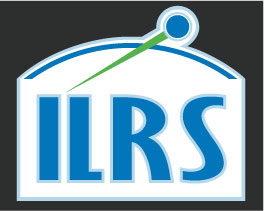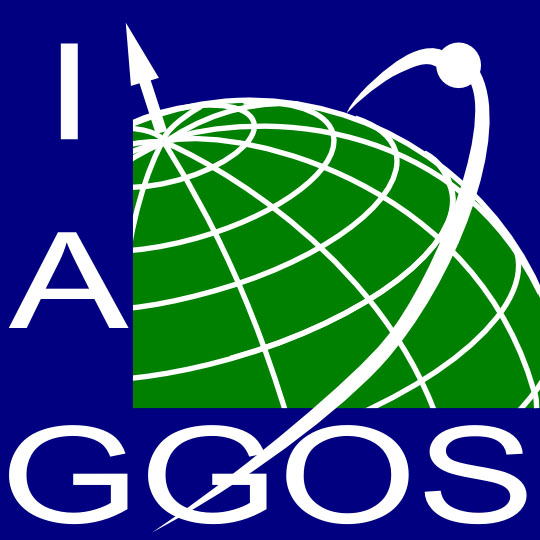
NanoFF A/B
Jump to: Mission Objectives, Mission Instrumentation, Mission Parameters, Additional Information
Mission Photos:
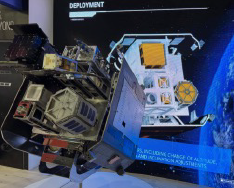 |
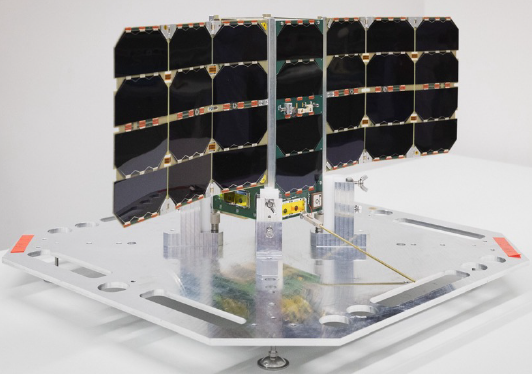 |
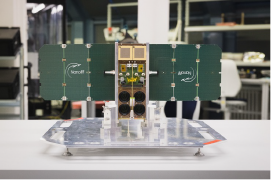 |
| Figure 1: A mock-up of the ION OTV (Orbit Transfer Vehicle) with a mock-up of the NanoFF CubeSat (with deployed solar panels), at the 75th International Astronautical Congress Milan, Italy, 2024, ©Jens Freymuth. | Figure 2: A NanoFF flight model with deployed solar panels ©Kevin Fuchs | Figure 3: Earth-facing side of a NanoFF satellite with cameras and deployed solar panels in the integration laboratory of TU Berlin |
Mission Objectives:
The NanoFF mission is a nanosatellite formation flying demonstration mission launched in December 2023, aimed at advancing proximity operations in low Earth orbit. The mission is funded by the German Aerospace Center (DLR) and developed by the Tehnical University of Berlin (Technische Universität Berlin). The NanoFF mission consists of two 2U-CubeSats designed to demonstrate precise relative navigation and control, leveraging GNSS-based positioning, inter-satellite communication, and autonomous formation-keeping algorithms. A key focus of NanoFF is to ensure collision-free operations while executing controlled maneuvers in close proximity, making it an important step towards future satellite servicing and inspection applications.
The two nanosatellites, NanoFF A and NanoFF B, were successfully launched on December 1st, 2023 on a SpaceX Falcon-9 launcher into a sun-synchronous orbit to perform formation flight ma-noeuvres. Both were released a few weeks later (on January 10th 2024 for NanoFF B and on January 15th, 2024 for NanoFF A) into a carefully designed partial helix orbit using D-Orbit’s ION orbit-transfer vehicle, and successfully guided into operations.
Mission Instruments and Payload:
Each 2U CubeSat has a mass of 3.2 kg and dimensions of 100 × 100 × 227 mm3. The Cubesats are divided into three parts of approximately equal size (propulsion 0.6U, bus 0.7U, payload 0.7U), of which both the bus and the payload are fully redundant. The NanoFF uses deployable solar panels to generate the needed power. Reaction wheels and magnetorquers as well as a combination of star, solar, magnetic field and angular rate sensors are used to provide high-precision attitude control, which is required for formation flight. Communication to and from the ground is handled via a UHF band and S-band (downlink only) links. The satellites can exchange data between themselves using UHF based intersatellite link (ISL).
Role of Laser Ranging
Laser ranging will be used to validate the absolute and relative navigation algorithms (based on GNSS raw measurements) which have been developed for the NanoFF mission. These algorithms will be first verified on the ground, and then later will be implemented on the NanoFF satellites for accurate relative navigation.
NanoFF Mission Parameters:
| Satellite | NANO FF A | NANO FF B |
| Sponsor: | DLR/Technical University of Berlin | DLR/Technical University of Berlin |
| Expected Life: | 4 years | 4 years |
| Primary Applications: | Technology demonstration. Fly a helix orbit. The satellites can be moved along-track in their orbits in order to change their distance and to demonstrate different application scenarios. The satellites will autonomous-ly maintain their relative posi-tions. | Technology demonstration. Fly a helix orbit. The satellites can be moved along-track in order to change the distance and to demonstrate different application scenarios. The satellites will autonomously maintain their relative positions. |
| COSPAR ID: | 2023-185T/2318518 | 2023-185S/2318517 |
| SIC Code: | 4205 | 4206 |
| Satellite Catalog (NORAD) Number: | 58810 | 58755 |
| Launch Date: | 01-Dec-2023 | 01-Dec-2023 |
| RRA Diameter: | 10 mm +/- 0.1 mm | 10 mm +/- 0.1 mm |
| RRA Shape: | Circular | Circular |
| Reflectors: | Corner cubes | Corner cubes |
| Orbit: | Near circular | Near circular | Inclination: | 97.5652 degrees | 97.5654 degrees |
| Eccentricity: | 0.00105054 | 0.00129725/td> |
| Apogee: | 545.158 km | 546.807 km |
| Perigee: | 530.626 km | 528.863 km |
| Period: | 95.399 min | 95.398 min |
| Weight: | 3.2 kg | 3.2 kg |
Additional Information:
Web sites:
- Cabinet Office, Government of Japan websites:
Publications:
- Roychowdhury, Debdeep, Sebastian Grau, and Enrico Stoll. "Helix orbit deployment of nanosatellites for formation flight: Strategy, GNSS/TLEs evaluation, and accuracy analysis." Acta Astronautica 232 (2025): 244-257.
- Roychowdhury D., Kapitola S., Boyer F., et al. (2024). “Lessons learned from the initial operations phase in the NanoFF Cubesat formation flight mission,” in the 75th International Astronautical Congress, 2024. (URL: https://dl.iafastro.directory/event/IAC-2024/paper/89779/)
- Roychowdhury D., Grau S., Ben-Larbi M. K. et al. (2023). “Feasibility analysis of rendezvous and docking operations in LEO for Cubesats with limited Delta-V budget,” in the 14th IAA Symposium on Small Satellites for Earth Observation, 2023.
- Roychowdhury D., Lim Y., and Weiss S. (2019). “Feasibility analysis of Low Earth Orbit nanosatellite formations with limited Delta-V budget,” in Proceedings of the 12th Symposium on Small Satellites for Earth Observation, 2019. (URL: https://iaaspace.org/wp-content/uploads/iaa/Scientific%20Activity/conf/sseo2021/berlin2019proceedings.pdf )
- Weiss S., Korn N., Wolf R., et al. (2019). “NanoFF: A 2U-Cubesat formation flight mission,” in the 70th International Astronautical Congress, 2019. (URL: https://iafastro.directory/iac/archive/browse/IAC-19/B4/IP/53609/)
Other:
- Debdeep Roychowdhury, Sascha Kapitola, Fynn Boyer & The NanoFF Team (2023), NanoFF Mission Operations, 2023 Virtual International Laser Ranging Workshop, October 16-20, 2023.
- Berlin’s Houston: Students at TU Berlin Develop Nanosatellites from Scratch, Article in WIRED, by Pavla Hubálková 10. 04. 2024 04:30.
- Technical University of Berlin Space Technology page January 16, 2024 news: https://www.tu.berlin/en/raumfahrttechnik/news-details/nanoff-a-und-b-erfolgreich-gestartet
